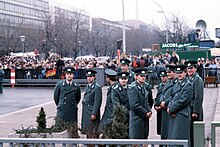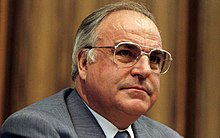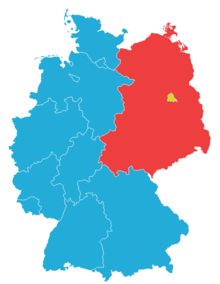German reunification
| This article needs additional citations for verification. Please help improve this article by adding reliable references. Unsourced material may be challenged and removed. (August 2007) |
The East German regime started to falter in May 1989, when removal of Hungary's border fence opened a hole in the Iron Curtain. It caused an exodus of thousands of East Germans fleeing to West Germany and Austria via Hungary. The Peaceful Revolution, a series of protests by East Germans, led to the GDR's first free elections on 18 March 1990, and to the negotiations between the GDR and FRG that culminated in a Unification Treaty,[1] whilst negotiations between the GDR and FRG and the four occupying powers produced the so-called "Two Plus Four Treaty" (Treaty on the Final Settlement with Respect to Germany) granting full sovereignty to a unified German state, whose two halves had previously still been bound by a number of limitations stemming from their post-WWII status as occupied regions. The united Germany remained a member of the European Community (later the European Union) and of NATO.
Contents[hide] |
[edit] Naming
There is debate as to whether the events of 1990 should be properly referred to as a "reunification" or a "unification". Proponents of the former use the term in contrast with the initial unification of Germany in 1871. Also when the Saarland joined the West German Federal Republic of Germany on 1 January 1957, this was termed the Small Reunification. Popular parlance, which uses "reunification", is deeply affected by the 1989 opening of the Berlin Wall (and the rest of the inner German border) and the physical reunification of the city of Berlin (itself divided only since 1945). Others, however, argue that 1990 represented a "unification" of two German states into a larger entity which, in its resulting form, had never before existed (see History of Germany).For political and diplomatic reasons, West German politicians carefully avoided the term "reunification" during the run-up to what Germans frequently refer to as die Wende. The official[1] and most common term in German is "Deutsche Einheit" (in English "German unity"). German unity is the term that Hans-Dietrich Genscher used in front of international journalists to correct them when they asked him about "reunification" in 1990.
After 1990, the term "die Wende" became more common. The term generally refers to the events (mostly in Eastern Europe) that led up to the actual reunification; in its usual context, this term loosely translates to "the turning point", without any further meaning. When referring to the events surrounding unification, however, it carries the cultural connotation of the time and the events in the GDR that brought about this "turnaround" in German history. However, civil rights activists from Eastern Germany rejected the term Wende as it was introduced by SED's Secretary General Egon Krenz.[2]
[edit] Process of reunification

A reunification treaty between West Germany and the GDR was negotiated in mid-1990, signed on 31 August of that year and finally approved by large majorities in the legislative chambers of both countries on 20 September 1990.[5] After that last step Germany was officially united at 00:00 CET on 3 October 1990. The five re-established federal states (Bundesländer) of East Germany – Brandenburg, Mecklenburg-Vorpommern, Saxony, Saxony-Anhalt, Thuringia – formally joined the Federal Republic of Germany, along with the city-state Berlin which formally came into being at the same time, created out of the still formally occupied West Berlin and East Berlin, and admitted to the federation. In practice however, West Berlin had already acted as an 11th state for most purposes, so Berlin is generally not included in the list of "New Länder".
The process chosen was one of two options implemented in the West German constitution (Grundgesetz; literally: Basic Law) of 1949. The constitution allowed - with (the then-existing) Article 23 - all Länder (German federative states), to give in their adhesion to the new Federal Republic. Thus the states' parliaments would vote in for their adhesion. The initial eleven joining states of 1949 comprised the Trizone and West Berlin. However the latter was legally inhibited by Allied objection due to the status of the city as a quadripartite allied occupation area.[6] In 1957 the Saar Protectorate joined West Germany under Article 23 procedure.
As the five newly-founded eastern German states formally joined the Federal Republic using the Article 23 procedure, the area in which the Basic Law was in force simply extended to include them.[7] The alternative would have been for East Germany to join as a whole along the lines of a formal union between two German states that then would have had to, amongst other things, create a new constitution for the newly established country.
Under the model that was chosen, however, the territory of the former German Democratic Republic was simply incorporated into the Federal Republic of Germany, and accordingly the Federal Republic of Germany, now enlarged to include the Eastern States, continued legally to exist under the same legal personality that was founded in May 1949.
Thus, the reunification was not a merger that created a third state out of the two, but an incorporation, by which West Germany absorbed East Germany. Thus, on Unification Day, October 3, 1990, the German Democratic Republic ceased to exist, giving way to five new Federal States, and East and West Berlin were also unified as a single city-state, forming a sixth new Federal State. The new Federal States immediately became parts of the Federal Republic of Germany, so that it was enlarged to include the whole territory of the former East Germany and Berlin.
The practical result of that model is that the now expanded Federal Republic of Germany continued to be a party to all the treaties it had signed prior to the moment of reunification, and thus continued the same membership of the U.N., NATO, the European Communities, etc; also, the same Basic Law and the same laws that were in force in the Federal Republic continued automatically in force, but now applied to the expanded territory.
To facilitate this process and to reassure other countries, some changes were made to the "Basic Law" (constitution). Article 146 was amended so that Article 23 of the current constitution could be used for reunification. After the five "New Länder" of East Germany had joined, the constitution was amended again to indicate that all parts of Germany are now unified. Article 23 was rewritten and it can still be understood as an invitation to others (e.g. Austria) to join, although the main idea of the change was to calm fears in (for example) Poland, that Germany would later try to rejoin with former parts of Germany that were now Polish or parts of other countries in the East. The changes effectively formalised the Oder-Neisse line as Germany's permanent eastern border. These amendments to the Basic Law were mandated by Article I, section 4 of the Two Plus Four Treaty.[8]

To commemorate the day that marks the official unification of the former East and West Germany in 1990, 3 October has since then been the official German national holiday, the Day of German Unity (Tag der deutschen Einheit). It replaced the previous national holiday held in West Germany on 17 June commemorating the Uprising of 1953 in East Germany and the national holiday on 7 October in the GDR.[4]
On 14 November 1990, the united Germany and Poland signed the German–Polish Border Treaty, finalising Germany's boundaries as permanent along the Oder-Neisse line, and thus, renouncing any claims to Silesia, East Brandenburg, Farther Pomerania, and territories of the former province of East Prussia.[9] The treaty also granted certain rights for political minorities on either side of the border.[10] The following month, the first all-German free elections since 1932 were held, resulting in an increased majority for the coalition government of Chancellor Helmut Kohl.
On 15 March 1991, the Treaty on the Final Settlement With Respect to Germany, that had been signed in September 1990 between the USSR, the USA, the United Kingdom, France, East Germany and West Germany, and that was ratified by the reunited Germany, entered into force, putting an end to the remaining limitations on German sovereignty that resulted from the post WWII arrangements.
[edit] Aftermath
| This section requires expansion. |
[edit] British and French opposition
According to Kremlin records that became public in 2009, the British and French governments did not want German "reunification".[13] Before the fall of the Berlin Wall, British Prime Minister Margaret Thatcher told Soviet President Gorbachev that neither Britain nor Western Europe wanted the reunification of Germany.[13] Thatcher also clarified that she wanted the Soviet leader to do what he could to stop it.[13] Thatcher said to Gorbachev "We do not want a united Germany".[13] Similarly, a representative of French President François Mitterrand reportedly told an aide to Gorbachev, "France by no means wants German reunification, although it realises that in the end it is inevitable."[13] Ultimately, however, both the UK and France ratified the Two Plus Four Treaty in September 1990, thus finalizing the reunification for purposes of international law.In October 2009, France released its archives from 1989–90 relating to the process of German reunification.[14] It was revealed that President Mitterrand agreed to German unification in exchange for a commitment from Chancellor Kohl to the European Economic and Monetary Union.[14]
In January 1990, Mitterrand told Thatcher that a unified Germany could "make more ground than even Hitler had".[15]
In March 1990 the French ambassador in London reported that Margaret Thatcher had told him, "France and Great Britain should pull together today in the face of the German threat."[15][16] Opposition in both countries was limited to older people, and there were no large-scale organised protests in either country.
[edit] Inner reunification


Politically, since the fall of the Wall, the successor party of the former East German socialist state party has become a major force in German politics. It was renamed PDS, and, later, merged with the Western leftist party WASG to form the party Die Linke (The Left).[19]
Constitutionally, the Grundgesetz, the West German constitution, provided two pathways for a unification, the first including an implementation of the constitution in the East, the second the implementation of a new all-German constitution, safeguarded by a popular referendum. While the former option was chosen as the most feasible one, the latter option was partly regarded as a means to foster the "inner reunification".[20][21]
A public manifestation of Vergangenheitsbewältigung is the existence of the so-called Birthler-Behörde, the Federal Commissioner for the Stasi Archives, which collects and maintains the files of the East German security apparatus.[22]
The economic reconstruction of former Eastern Germany following the reunification required large amounts of public funding which turned some areas into boom regions, although overall unemployment remains higher than in the former West.[23]
In terms of media usage and reception, the country remains largely divided. Mentality gaps between East and West persist, but so does sympathy.[18] Additionally, the daily-life exchange of Easterners and Westerners is not so large as expected.[24][25] Especially young people's knowledge of former East Germany is very low.[26] Some people in former Eastern Germany engage in Ostalgia, which is a certain nostalgia for the time before the wall came down.[27]
Today, there are several prominent East Germans shaping the image of Germany at home and abroad, including Kurt Masur, Michael Ballack, Katharina Witt, and Angela Merkel.


